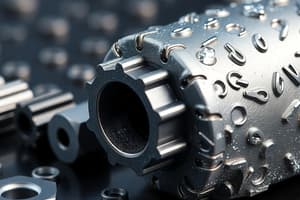Podcast
Questions and Answers
What is the density of Aluminum at 20°C?
What is the density of Aluminum at 20°C?
- 2.71 g/cm³ (correct)
- 8.94 g/cm³
- 3.5 g/cm³
- 1.85 g/cm³
Which element has the highest melting point among the selected elements?
Which element has the highest melting point among the selected elements?
- Boron
- Beryllium
- Chromium
- Carbon (correct)
What is the valence of Chlorine?
What is the valence of Chlorine?
- 3+
- 1+
- 2+
- 1- (correct)
Which atomic structure is associated with Barium?
Which atomic structure is associated with Barium?
What is the atomic weight of Argon?
What is the atomic weight of Argon?
Which element has a hexagonal crystal structure?
Which element has a hexagonal crystal structure?
What is the ionic radius of Beryllium?
What is the ionic radius of Beryllium?
What is the most common valence of Cobalt?
What is the most common valence of Cobalt?
What is the primary material discussed that features a body-centered cubic structure?
What is the primary material discussed that features a body-centered cubic structure?
Which of the following roles is responsible for overseeing the book's editorial program?
Which of the following roles is responsible for overseeing the book's editorial program?
Who is the Executive Publisher of the book?
Who is the Executive Publisher of the book?
What type of paper is the book printed on?
What type of paper is the book printed on?
In which year was the copyright for the book last updated?
In which year was the copyright for the book last updated?
Which individual is associated with the cover art of the book?
Which individual is associated with the cover art of the book?
Which department should requests for permission to reproduce parts of the publication be addressed to?
Which department should requests for permission to reproduce parts of the publication be addressed to?
What is the role of Jessica Knecht in the publishing process?
What is the role of Jessica Knecht in the publishing process?
What was the primary discovery regarding the properties of materials over time?
What was the primary discovery regarding the properties of materials over time?
Which of the following materials has evolved to meet the complex needs of modern society?
Which of the following materials has evolved to meet the complex needs of modern society?
What factor is crucial for altering the characteristics of materials?
What factor is crucial for altering the characteristics of materials?
How did advancements in materials understanding relate to technology development?
How did advancements in materials understanding relate to technology development?
Which material is specifically mentioned as critical for the automotive industry?
Which material is specifically mentioned as critical for the automotive industry?
Which subdiscipline is NOT mentioned in association with materials science?
Which subdiscipline is NOT mentioned in association with materials science?
What has been the impact of materials availability on societal technologies?
What has been the impact of materials availability on societal technologies?
In which era did understanding material structure and properties significantly advance?
In which era did understanding material structure and properties significantly advance?
What is primarily influenced by phase transformations in materials?
What is primarily influenced by phase transformations in materials?
Which type of diagrams are used to analyze phase transformations in iron-carbon alloys?
Which type of diagrams are used to analyze phase transformations in iron-carbon alloys?
What is the focus of the section on tempered martensite?
What is the focus of the section on tempered martensite?
In the context of iron-carbon alloys, what characterizes metastable states?
In the context of iron-carbon alloys, what characterizes metastable states?
Which phenomenon is associated with the brittle fracture of ceramics?
Which phenomenon is associated with the brittle fracture of ceramics?
What is the main aspect examined in the study of precipitation hardening?
What is the main aspect examined in the study of precipitation hardening?
What is the significance of continuous-cooling transformation diagrams in material science?
What is the significance of continuous-cooling transformation diagrams in material science?
What is a key characteristic of mechanical behavior in iron-carbon alloys?
What is a key characteristic of mechanical behavior in iron-carbon alloys?
Which category of properties includes characteristics like elastic modulus and strength?
Which category of properties includes characteristics like elastic modulus and strength?
What type of field is the stimulus for determining electrical properties?
What type of field is the stimulus for determining electrical properties?
Which of the following properties is related to the response of materials under heat?
Which of the following properties is related to the response of materials under heat?
In the context of material science, what does the category of deteriorative characteristics measure?
In the context of material science, what does the category of deteriorative characteristics measure?
What is the primary interrelationship among processing, structure, properties, and performance in materials science?
What is the primary interrelationship among processing, structure, properties, and performance in materials science?
Which of the following properties would be classified under the optical category?
Which of the following properties would be classified under the optical category?
What does the term 'elastic modulus' particularly relate to?
What does the term 'elastic modulus' particularly relate to?
Which of the following is NOT considered one of the six categories of material properties?
Which of the following is NOT considered one of the six categories of material properties?
Flashcards are hidden until you start studying
Study Notes
Introduction to Materials Science and Engineering
- The focus of materials science and engineering is understanding the relationship between the structural elements of materials and their properties.
- This knowledge has led to the creation of tens of thousands of different materials with specific characteristics that meet the needs of modern society.
- Material utilization has evolved from a basic selection process to a complex understanding of material properties and structure.
- The development of many technologies, such as automobiles and electronic devices, relies on the availability of suitable materials.
Materials Science and Engineering Subdisciplines
- Materials science studies the properties of materials and their relationship to structure, processing, and performance.
- Materials engineering focuses on designing and developing new materials with specific properties and characteristics.
Major Material Property Categories
- Six major categories of material properties are:
- Mechanical: Relating deformation to applied load or force (e.g., stiffness, strength, toughness).
- Electrical: Relating to the response of materials to an electric field (e.g., electrical conductivity, dielectric constant).
- Thermal: Describing the behavior of materials in response to heat (e.g., heat capacity, thermal conductivity).
- Magnetic: Relating to the response to a magnetic field.
- Optical: Characterizing the interaction of materials with light radiation (e.g., index of refraction, reflectivity).
- Deteriorative: Explaining how materials react to environmental factors (e.g., corrosion, oxidation).
Processing-Structure-Properties-Performance Relationship
- Processing refers to how a material is manufactured or treated.
- Structure describes the arrangement of atoms and molecules within a material.
- Properties are the characteristics of a material, such as its strength, conductivity, or color.
- Performance is how a material behaves in a specific application.
- The processing of a material directly influences its structure, which in turn dictates its properties. These properties ultimately determine the material's performance in a given application.
Studying That Suits You
Use AI to generate personalized quizzes and flashcards to suit your learning preferences.




